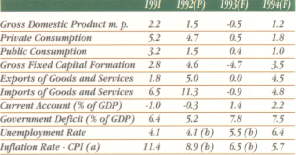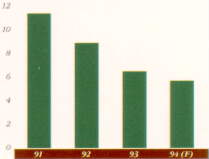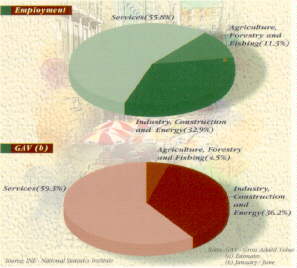

 ortugal has been one of Europe's fastest growing economies, with a sustained growth which began in mid-1985.
ortugal has been one of Europe's fastest growing economies, with a sustained growth which began in mid-1985.
 Real term growth rates |
|
 he opening of the Portuguese economy has decisively contributed to this success, and while the international recession also affected the domestic economy, particularly in 1993, the outlook for 1994 suggests that recovery is on the way. he opening of the Portuguese economy has decisively contributed to this success, and while the international recession also affected the domestic economy, particularly in 1993, the outlook for 1994 suggests that recovery is on the way. |
 Source: 1991/92 - Bank of Portugal, INE - National Statistics Institute; 1993/94 - OECD Notes: (a) Consumer Price Index; (b) Actual - INE; (P) Provisional data; (F) Forecast |

|
|
|
Employment and Inflation have also achieved remarkable results during this period. In 1986 Portugal had one of the highest unemployment rates in the EC; today, with about 6% it has one of the lowest rates in the European Union (EU). |
 Source: INE - National Statistics Institute Notes: (a) Consumer Price Index; (F) OECD Forecast |
|
Inflation has been reduced from 11.4% in 1991 to 6.5% in 1993. In 1994 inflation rate is expected to decrease to 5.7%. |
|
 |
|
|
Although domestic economic development since 1985 was favoured by the dollar exchange rates, falling oil prices, and the advantages stemming from Portugal's 1986 EC entry, it is clear that modernization programmes and productive investment have been crucial to business decisions. The improved national economic structure indicates a positive response to the new incentives. Programmes covering the various areas of economic activity have contributed greatly to the restructuring of industry, tourism, agriculture and distribution. |

|
|
Restructuring of the economy has resulted in the service sector accounting for 56% of the active population today, while it represented 35% ten years ago. The importance of the agricultural sector has been steadily declining. |
|
Developed by
United Nations Trade Point Development Centre
For more information about Portugal
Investimentos, Comércio e Turismo de Portugal, ICEP